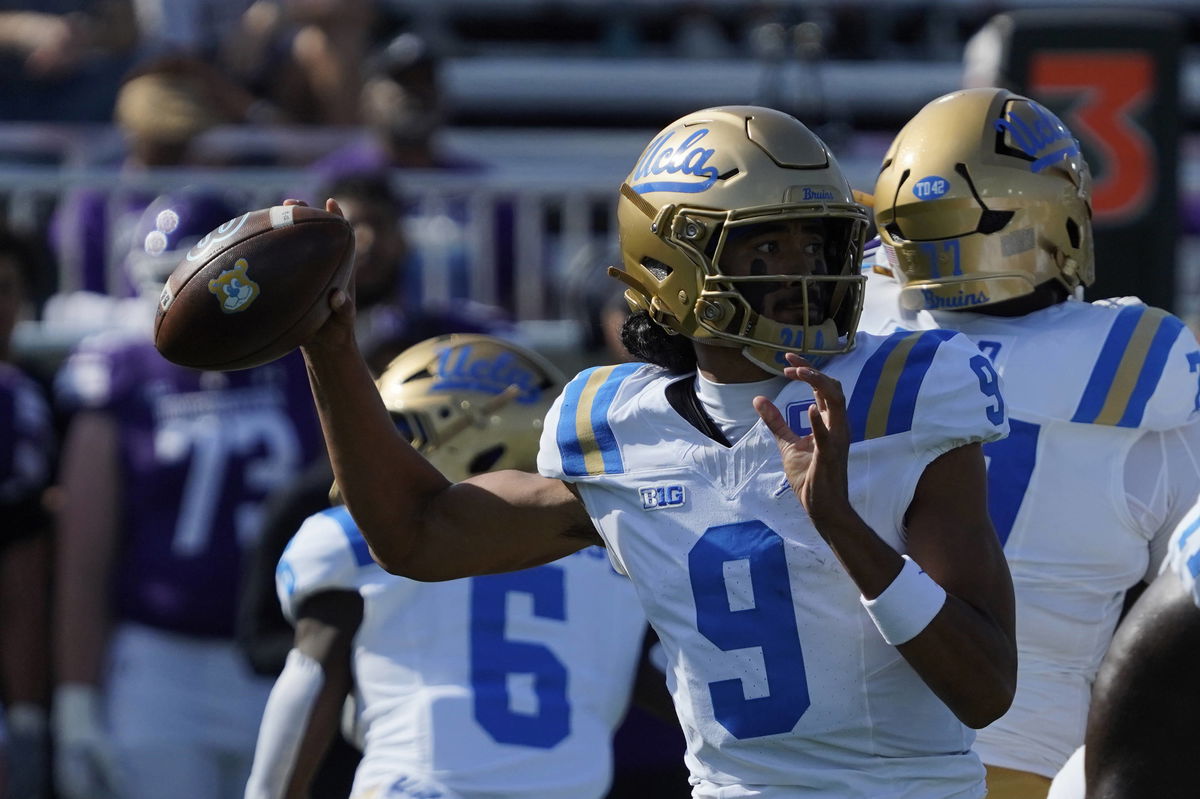
Imago
NCAA, College League, USA Football: UCLA at Northwestern Sep 27, 2025 Evanston, Illinois, USA UCLA Bruins quarterback Nico Iamaleava 9 passes the ball against the Northwestern Wildcats during the first half at Northwestern Medicine Field at Martin Stadium. Evanston Northwestern Medicine Field at Martin Stadium Illinois USA, EDITORIAL USE ONLY PUBLICATIONxINxGERxSUIxAUTxONLY Copyright: xDavidxBanksx 20250927_sns_bb6_00045

Imago
NCAA, College League, USA Football: UCLA at Northwestern Sep 27, 2025 Evanston, Illinois, USA UCLA Bruins quarterback Nico Iamaleava 9 passes the ball against the Northwestern Wildcats during the first half at Northwestern Medicine Field at Martin Stadium. Evanston Northwestern Medicine Field at Martin Stadium Illinois USA, EDITORIAL USE ONLY PUBLICATIONxINxGERxSUIxAUTxONLY Copyright: xDavidxBanksx 20250927_sns_bb6_00045
Last week’s 38–13 win over Michigan State showed exactly what UCLA can be when everything clicks. But as the Bruins gear up for their homecoming clash against Maryland, new reports suggest that their week of preparation has taken an unexpected turn. The issue? Not injuries, not fatigue, but their own practice field.
Watch What’s Trending Now!
To address the issue, UCLA beat reporter Ben Bolch shared footage on X that showed the Bruins’ newly renovated Spaulding Field completely waterlogged, its surface pooling with standing water and forcing UCLA to abandon practice there. For a program that just invested in a state-of-the-art grass installation, this scene raised eyebrows.
Bolch questioned why UCLA hadn’t opted for a split-surface setup, one artificial turf field and one grass, a design that would have ensured uninterrupted practice despite rain or drainage issues. It’s a fair point. The program had such an option, and yet, they chose to go all-in on grass to mirror the Rose Bowl’s natural surface. Now, that decision may be haunting them.
ADVERTISEMENT
Bolch took to X and wrote, “This once again raises the issue of why UCLA didn’t go with one 80-yard artificial turf field and another one that was grass to mitigate potential rain/drainage problems and ensure you could hold practice no matter what.” But what went wrong?
This once again raises the issue of why UCLA didn’t go with one 80-yard artificial turf field and another one that was grass to mitigate potential rain/drainage problems and ensure you could hold practice no matter what. https://t.co/8iCnuJgNcP
— Ben Bolch (@latbbolch) October 14, 2025
Spaulding Field’s renovation was supposed to be the fix. The project included new irrigation and drainage systems, addressing long-standing infrastructure issues tied to the construction of the Wasserman Football Center back in 2017. The updates even featured a 75,000-gallon stormwater detention system to prevent flooding on-site.
ADVERTISEMENT
Yet, after recent rains, the new grass failed to drain properly, suggesting either a delay in the system’s activation or an early fault in its design. UCLA has since moved practice sessions to the Intramural Field, a synthetic-turf surface built in 2015 precisely to provide an all-weather option. It’s a temporary solution, but not an ideal one for a team that just started finding rhythm under interim leadership.
ADVERTISEMENT
Will the training ground mishap be a factor on Saturday for Nico Iamaleava?
For quarterback Nico Iamaleava and the Bruins, this couldn’t come at a more delicate moment. After a chaotic first half of the season, coaching changes, offensive struggles, and a 2–4 start, the win over Michigan State finally brought optimism back to Westwood. Now, as UCLA prepares to host a dangerous Maryland team that started the year 4–0, they’re forced to make late-week practice adjustments.
ESPN’s analytics now call the matchup a coin toss, giving UCLA just a 49.8% chance to win, proof that even small disruptions can matter at this stage. Still, it’s hard to imagine a little water will derail a team that’s already weathered far worse.
This season has tested UCLA’s resilience. After parting ways with head coach DeShaun Foster, interim head coach Tim Skipper has steadied the ship, going 2–1 since taking over. Offensive coordinator Jerry Neuheisel, another meantime appointment, has revitalized the offense, helping Iamaleava and running back Jalen Berger rediscover their rhythm.
ADVERTISEMENT
So, it seems unlikely that UCLA’s training ground adversity will affect them on Saturday.
ADVERTISEMENT
ADVERTISEMENT
ADVERTISEMENT

